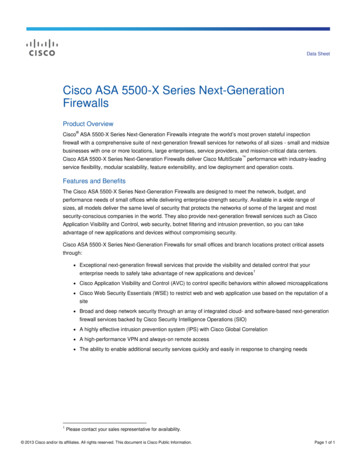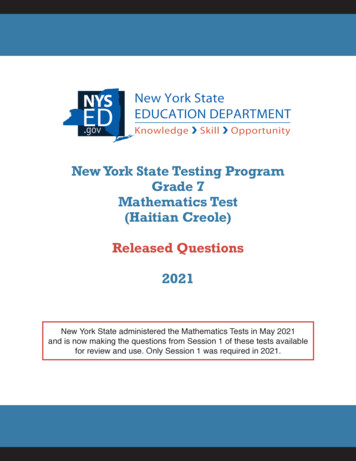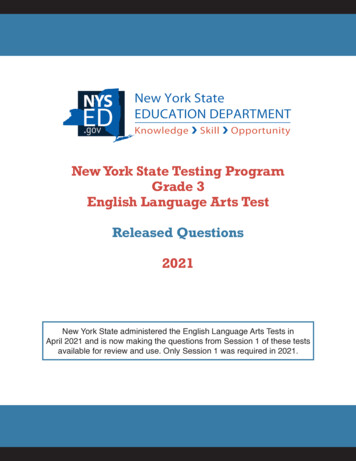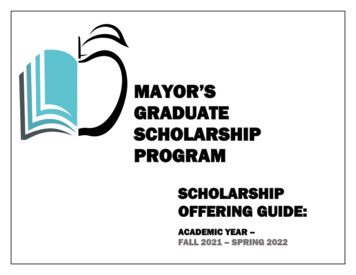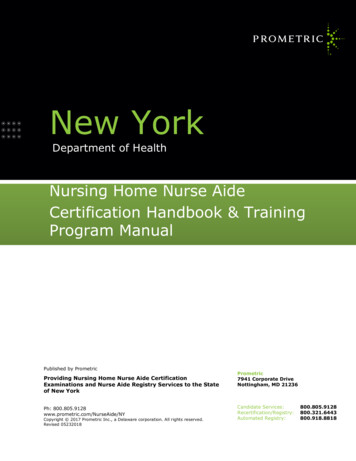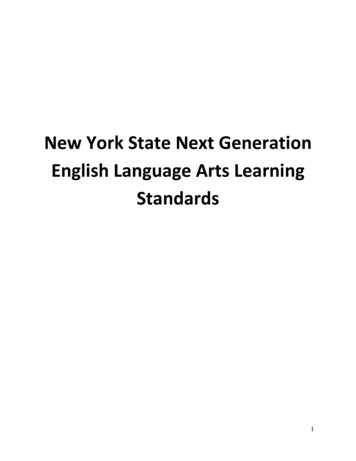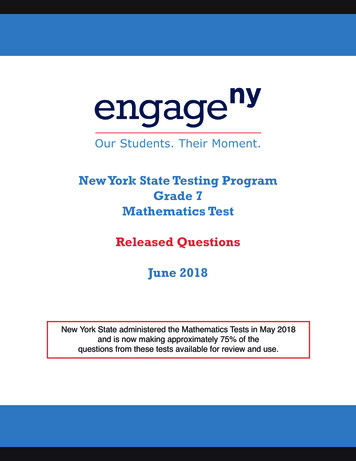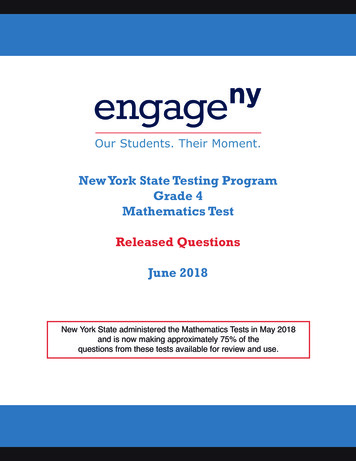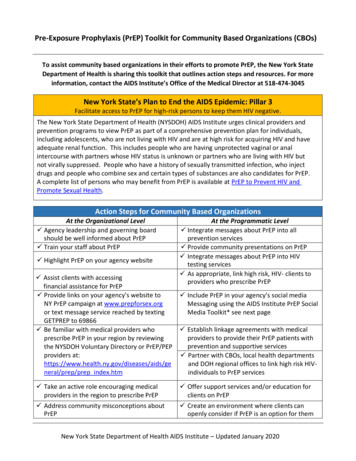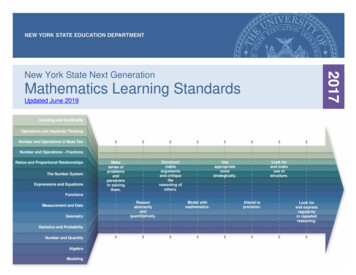
Transcription
2017New York State Next GenerationMathematics Learning StandardsUpdated June 2019Counting and CardinalityOperations and Algebraic ThinkingNumber and Operations in Base TenNumber and Operations – FractionsRatios and Proportional RelationshipsThe Number SystemExpressions and EquationsConstructviableargumentsand critiquethereasoning ofothers.Makesense ofproblemsandperseverein solvingthem.Useappropriatetoolsstrategically.Look forand makeuse ofstructure.FunctionsMeasurement and DataGeometryStatistics and ProbabilityNumber and tively.Model withmathematics.Attend toprecision.Look forand expressregularityin repeatedreasoning.
New York State Next Generation Mathematics Learning Standards (2017)Table of ContentsIntroductionStandards for Mathematical PracticePre-KindergartenKindergartenGrade 1Grade 2Grade 3Grade 4Grade 5Grade 6Grade 7Grade 8High School — IntroductionAlgebra IGeometryAlgebra IIThe Plus ( ) StandardsStandards Updates (June 2019)Works 69170Page 2
New York State Next Generation Mathematics Learning Standards (2017)IntroductionIn 2015, New York State (NYS) began a process of review and revision of its current mathematics standards adopted in January of 2011. Through numerous phases of publiccomment, virtual and face-to-face meetings with committees consisting of NYS educators (Special Education, Bilingual Education and English as a New Language teachers),parents, curriculum specialists, school administrators, college professors, and experts in cognitive research, the New York State Next Generation Mathematics LearningStandards (2017) were developed. These revised standards reflect the collaborative efforts and expertise of all constituents involved.The New York State Next Generation Mathematics Learning Standards (2017) reflect revisions, additions, vertical movement, and clarifications to the current mathematicsstandards. The Standards are defined as the knowledge, skills and understanding that individuals can and do habitually demonstrate over time because of instruction andlearning experiences. These mathematics standards, collectively, are focused and cohesive—designed to support student access to the knowledge and understanding of themathematical concepts that are necessary to function in a world very dependent upon the application of mathematics, while providing educators the opportunity to deviseinnovative programs to support this endeavor. As with any set of standards, they need to be rigorous; they need to demand a balance of conceptual understanding, proceduralfluency and application and represent a significant level of achievement in mathematics that will enable students to successfully transition to post-secondary education andthe workforce.Context for Revision of the NYS Next Generation Mathematics Learning Standards (2017)Changing expectations for mathematics achievementToday’s children are growing up in a world very different from the one even 15 years ago. Seismic changes in the labor market mean that we are living and working in aknowledge-based economy—one that demands advanced literacy and Science, Technology, Engineering and Mathematics (STEM) skills, whether for application in the privateor public sector. Today, information moves through media at lightning speeds and is accessible in ways that are unprecedented; technology has eliminated many jobs whilechanging and creating others, especially those involving mathematical and conceptual reasoning skills. One characteristic of these fast-growing segment of jobs is that theemployee needs to be able to solve unstructured problems while working with others in teams. At the same time, migration and immigration rates around the world bringdiversity to schools and neighborhoods. The exponential growth in interactions and information sharing from around the world means there is much to process, communicate,analyze and respond to in the everyday, across all settings. For a great majority of jobs, conceptual reasoning and technical writing skills are integral parts to the daily routine.To prepare students for the changes in the way we live and work, and to be sure that our education system keeps pace with what it means to be mathematically literate andwhat it means to collaboratively problem solve, we need a different approach to daily teaching and learning. We need content-rich standards that will serve as a platform foradvancing children’s 21st-century mathematical skills —their abstract reasoning, their collaboration skills, their ability to learn from peers and through technology, and theirflexibility as a learner in a dynamic learning environment. Students need to be engaged in dialogue and learning experiences that allow complex topics and ideas to beexplored from many angles and perspectives. They also need to learn how to think and solve problems for which there is no one solution—and learn mathematical skills alongthe way.Increasingly Diverse Learner PopulationsThe need for a deeper, more innovative approach to mathematics teaching comes at a time when the system is already charged with building up language skills among theincreasingly diverse population. Students who are English Language Learners (ELLs)/Multilingual Learners (MLLs) now comprise over 20% of the school-age population, whichreflects significant growth in the past several decades. Between 1980 and 2009, this population increased from 4.7 to 11.2 million young people, or from 10 to 21% of theschool-age population. This growth will likely continue in U.S. schools; by 2030, it is anticipated that 40% of the school-age population in the U.S. will speak a language otherthan English at home. (1) Today, in schools and districts across the U.S., many students other than those classified as ELLs are learning English as an additional language, even ifnot in the initial stages of language development—these children are often described as “language minority learners.” Likewise, many students, large numbers of whom aregrowing up in poverty, speak a dialect of English that is different from the academic English found in school curriculum. (2) (3) (4)Linked Navigation: Intro, MP, PK, K, 1, 2, 3, 4, 5, 6, 7, 8, HS Intro, Algebra I, Geometry, Algebra II, Plus, CitationsPage 3
New York State Next Generation Mathematics Learning Standards (2017)Each of these groups—ELLs/MLLs, language minority learners, and students acquiring academic English—often struggle to access the language, and therefore the knowledgethat fills the pages of academic texts, despite their linguistic assets. Therefore, the context for this new set of Mathematics Standards is that there is a pressing need to provideinstruction that not only meets, but exceeds standards, as part of system-wide initiative to promote equal access to math skills for all learners while capitalizing on linguisticand cultural diversity.All academic work does, to some degree, involve the academic language needed for success in school. For many students, including ELLs/MLLs, underdeveloped academiclanguage affects their ability to comprehend and analyze texts, limits their ability to write and express their mathematical reasoning effectively, and can hinder theiracquisition of academic content in all academic areas in which learning is demonstrated and assessed through oral and written language. If there isn’t sufficient attention paidto building academic language across all content areas, students, including ELLs/MLLs, will not reach their potential and we will continue to perpetuate achievement gaps. Thechallenge is to design instruction that acknowledges the role of language; because language and knowledge are so inextricable.In summary, today’s children live in a society where many of their peers are from diverse backgrounds and speak different languages; one where technology is ubiquitous andcentral to daily life. They will enter a workforce and economy that demands critical thinking skills, and strong communication and social skills for full participation in society.This new society and economy has implications for today’s education system—especially our instruction to foster a deeper and different set of communication and criticalthinking skills, with significant attention to STEM.Students with Disabilities and the StandardsOne of the fundamental tenets guiding educational legislation (the No Child Left Behind Act, and Every Student Succeeds Act), and related policies over the past 15-years, is thatall students, including students with disabilities, can achieve high standards of academic performance. A related trend is the increasing knowledge and skill expectations forPreK-Grade 12 students, especially in the area of reading and language arts, required for success in postsecondary education and 21st Century careers. Indeed, underdevelopedliteracy skills have profound academic, social, emotional, and economic consequences for students, families, and society.At the same time, the most recently available federal data (5) presents a portrait of the field reflecting both challenges and opportunities. Students served under IDEA, Part B: During the 2012-13 school year, there was a total of 5.83 million students with disabilities, ages 6-21; an increase from 5.67million in 2010-11. Access to the general education program: More than 60 percent (62.1%) of students, ages 6 through 21 served under IDEA, Part B, were educated in the regularclassroom 80% or more of the day, up from 60.5% in 2010-11. Participation in state assessments: Between 68.1 and 84.1 percent of students with disabilities in each of grades 3 through 8 and high school participated in theregular state assessment in reading based on grade-level academic achievement standards with or without accommodations. English language arts proficiency: The median percentages of students with disabilities in grades 3 through 8 and high school who were administered the 2012-13state assessment in reading based on grade-level academic achievement standards who were proficient ranged from 25.4 to 37.3 percent. Graduation: Over sixty percent (65.1%) of students with disabilities graduated with a regular high school diploma.Overall, the number of students with disabilities is increasing nationwide, as is their access to the general education curriculum, and participation in the state ELA andmathematics assessments. Attaining proficiency and graduating with a regular high school diploma are areas where significant improvements are needed.Therefore, each student’s individualized education program (IEP) must be developed in consideration of the State learning standards and should include information forteachers to effectively provide supports and services to address the individual learning needs of the student as they impact the student’s ability to participate and progress inthe general education curriculum. In addition to supports and services, special education must include specially designed instruction, which means adapting, as appropriate,the content, methodology or delivery of instruction to address the unique needs that result from the student’s disability. By so doing, the teacher ensures each student’saccess to the general education curriculum so that he or she can meet the learning standards that apply to all students. The Blueprint for Improved Results for Students withDisabilities focuses on seven core evidence-based principles for students with disabilities to ensure they have the opportunity to benefit from high quality instruction and toLinked Navigation: Intro, MP, PK, K, 1, 2, 3, 4, 5, 6, 7, 8, HS Intro, Algebra I, Geometry, Algebra II, Plus, CitationsPage 4
New York State Next Generation Mathematics Learning Standards (2017)reach the same academic standards as all students. For additional information, please see the Office of Special Education’s field advisory: Blueprint for Improved Results forStudents with Disabilities.Understanding the NYS Next Generation Mathematics Learning Standards (2017)The NYS Next Generation Mathematics Learning Standards (2017) define what students should understand and be able to do as a result of their study of mathematics. Toassess progress on the Standards, a teacher must assess whether the student has understood what has been taught and provide opportunities where a student canindependently use and apply this knowledge to solve mathematical problems in similar or new contexts. While procedural skills are relatively straightforward to assess,teachers often ask: what does mathematical understanding look like? One hallmark of mathematical understanding is the ability to justify, in a way appropriate to thestudent’s mathematical maturity, why a particular mathematical statement is accurate or where a mathematical rule comes from. Correctly using language to articulatemathematical understanding plays a part in this justification. Making the distinction between mathematical understanding and procedural skill is critical when designingcurriculum and assessment; both are important for the mastery of these standards. That is, there is a world of difference between a student who can summon a mnemonicdevice to expand a product such as (a b)(x y) and a student who can explain what the mnemonic represents as a process for systematically approaching algebraic problems.The student who can explain the rule understands the mathematics, and may have a better chance to succeed at a less familiar task, such as expanding (a b c)(x y).The Standards set grade-specific standards but do not define the intervention methods or materials necessary to support students who are well below or well above gradelevel expectations. It is also beyond the scope of the Standards to define the full range of supports appropriate for English Language Learners (ELLs)/Multilingual Learners(MLLs) and for Students with Disabilities. However, the department ensured that teachers of English Language Learners (ELLs)/Multilingual Learners (MLLs) and Students withDisabilities participated in the revision of the standards. The New York State Education Department (NYSED) has created two statewide frameworks, the Blueprint for ImprovedResults for Students with Disabilities and the Blueprint for English Language Learner Success, aimed to clarify expectations and to provide guidance for administrators,policymakers, and practitioners to prepare ELLs/MLLs and Students with Disabilities for success. These principles therein the frameworks are intended to enhanceprogramming and improve instruction that would allow for students within these populations to reach the same standards as all students and leave school prepared tosuccessfully transition to post school learning, living and working.No set of grade-specific standards can fully reflect the variation in learning profiles, rates, and needs, linguistic backgrounds, and achievement levels of students in any givenclassroom. When designing and delivering mathematics instruction, educators must consider the cultural context and prior academic experiences of all students while bridgingprior knowledge to new knowledge and ensuring that content is meaningful and comprehensible. In addition, as discussed above, educators must consider the relationship oflanguage and content, and the vital role that language plays in obtaining and expressing mathematics content knowledge. The standards should be read as allowing for thewidest possible range of students to participate fully from the outset, along with appropriate adaptations to ensure equitable access and maximum participation of allstudents.Linked Navigation: Intro, MP, PK, K, 1, 2, 3, 4, 5, 6, 7, 8, HS Intro, Algebra I, Geometry, Algebra II, Plus, CitationsPage 5
New York State Next Generation Mathematics Learning Standards (2017)How to Read the P-8 Standards for Mathematical Content*See High School – Introduction for how to read the High School Standards for Mathematical Content.The standards are organized by grade level from Prekindergarten through grade eight.Standards define what students should understand and be able to do.Clusterssummarize groups of related standards. Note that standards from different clusters may sometimes be closely related, because mathematics is a connected subject.Domains are larger groups of related standards. Standards from different domains may sometimes be closely related.Coherence Linkagesconnect standards one grade level forward and/or back when there are very direct linking standards in those grades. For a more thorough analysisof how standards link to one another, see are indicated by a blue number when information was taken or adapted from another source. The number will match the source number in theWorks Cited section at the end of this document. When viewing these standards electronically, the source information (including page number) willappear as hover-over text.Prekindergarten through Grade EightCitationThe order in which the standards are presented is not necessarily the order in which the standards need to be taught. Standards from various domains are connected, andeducators will need to determine the best overall design and approach, as well as the instructional strategies needed to support their learners to attain grade-levelexpectations and the knowledge articulated in the standards. That is, the standards do not dictate curriculum or teaching methods; learning opportunities and pathways willcontinue to vary across schools and school systems, and educators should make every effort to meet the needs of individual students, based on their pedagogical andprofessional impressions and information.Linked Navigation: Intro, MP, PK, K, 1, 2, 3, 4, 5, 6, 7, 8, HS Intro, Algebra I, Geometry, Algebra II, Plus, CitationsPage 6
New York State Next Generation Mathematics Learning Standards (2017)The Standards for Mathematical PracticeThe Standards for each grade level and course begin with eight Standards for Mathematical Practice. The Standards for Mathematical Practice describe varieties of expertisethat mathematics educators at all levels should seek to develop in their students. These practices rest on important “processes and proficiencies” with longstandingimportance in mathematics education. The first of these are the NCTM process standards of problem solving, reasoning and proof, communication, representation, andconnections. (6) The second are the strands of mathematical proficiency specified in the National Research Council’s report Adding it Up: adaptive reasoning, strategiccompetence, conceptual understanding (comprehension of mathematical concepts, operations and relations), procedural fluency (skill in carrying out procedures flexibly,accurately, efficiently and appropriately), and productive disposition (habitual inclination to see mathematics as sensible, useful, and worthwhile, coupled with a belief indiligence and one’s own efficacy).1. Make sense of problems and persevere in solving them.Mathematically proficient students start by explaining to themselves the meaning of a problem and looking for entry points to its solution. They analyze givens, constraints,relationships, and goals. They make conjectures about the form and meaning of the solution and plan a solution pathway rather than simply jumping into a solution attempt.They consider analogous problems, and try special cases and simpler forms of the original problem in order to gain insight into its solution. They monitor and evaluate theirprogress and change course if necessary. Older students might, depending on the context of the problem, transform algebraic expressions or change the viewing window ontheir graphing calculator to get the information they need. Mathematically proficient students can explain correspondences between equations, verbal descriptions, tables,and graphs or draw diagrams of important features and relationships, graph data, and search for regularity or trends. Younger students might rely on using concrete objects orpictures to help conceptualize and solve a problem. Mathematically proficient students check their answers to problems using a different method, and they continually askthemselves, “Does this make sense?” They can understand the approaches of others to solving complex problems and identify correspondences between different approaches.2. Reason abstractly and quantitatively.Mathematically proficient students make sense of quantities and their relationships in problem situations. They bring two complementary abilities to bear on problemsinvolving quantitative relationships: the ability to decontextualize—to abstract a given situation and represent it symbolically and manipulate the representing symbols as ifthey have a life of their own, without necessarily attending to their referents—and the ability to contextualize, to pause as needed during the manipulation process in order toprobe into the referents for the symbols involved. Quantitative reasoning entails habits of creating a coherent representation of the problem at hand; considering the unitsinvolved; attending to the meaning of quantities, not just how to compute them; and knowing and flexibly using different properties of operations and objects.3. Construct viable arguments and critique the reasoning of others.Mathematically proficient students understand and use stated assumptions, definitions, and previously established results in constructing arguments. They make conjecturesand build a logical progression of statements to explore the truth of their conjectures. They are able to analyze situations by breaking them into cases, and can recognize anduse counterexamples. They justify their conclusions, communicate them to others, and respond to the arguments of others. They reason inductively about data, makingplausible arguments that take into account the context from which the data arose. Mathematically proficient students are also able to compare the effectiveness of twoplausible arguments, distinguish correct logic or reasoning from that which is flawed, and—if there is a flaw in an argument—explain what it is. Elementary students canconstruct arguments using concrete referents such as objects, drawings, diagrams, and actions. Such arguments can make sense and be correct, even though they are notgeneralized or made formal until later grades. Later, students learn to determine domains to which an argument applies. Students at all grades can listen or read thearguments of others, decide whether they make sense, and ask useful questions to clarify or improve the arguments.4. Model with mathematics.Mathematically proficient students can apply the mathematics they know to solve problems arising in everyday life, society, and the workplace. In early grades, this might beas simple as writing an addition equation to describe a situation. In middle grades, a student might apply proportional reasoning to plan a school event or analyze a problem inthe community. By high school, a student might use geometry to solve a design problem or use a function to describe how one quantity of interest depends on another.Mathematically proficient students who can apply what they know are comfortable making assumptions and approximations to simplify a complicated situation, realizing thatLinked Navigation: Intro, MP, PK, K, 1, 2, 3, 4, 5, 6, 7, 8, HS Intro, Algebra I, Geometry, Algebra II, Plus, CitationsPage 7
New York State Next Generation Mathematics Learning Standards (2017)these may need revision later. They are able to identify important quantities in a practical situation and map their relationships using such tools as diagrams, two-way tables,graphs, flowcharts and formulas. They can analyze those relationships mathematically to draw conclusions. They routinely interpret their mathematical results in the contextof the situation and reflect on whether the results make sense, possibly improving the model if it has not served its purpose.5. Use appropriate tools strategically.Mathematically proficient students consider the available tools when solving a mathematical problem. These tools might include pencil and paper, concrete models, a ruler, aprotractor, a calculator, a spreadsheet, a computer algebra system, a statistical package, or dynamic geometry software. Proficient students are sufficiently familiar with toolsappropriate for their grade or course to make sound decisions about when each of these tools might be helpful, recognizing both the insight to be gained and their limitations.For example, mathematically proficient high school students analyze graphs of functions and solutions generated using a graphing calculator. They detect possible errors bystrategically using estimation and other mathematical knowledge. When making mathematical models, they know that technology can enable them to visualize the results ofvarying assumptions, explore consequences, and compare predictions with data. Mathematically proficient students at various grade levels are able to identify relevantexternal mathematical resources, such as digital content located on a website, and use them to pose or solve problems. They are able to use technological tools to explore anddeepen their understanding of concepts.6. Attend to precision.Mathematically proficient students try to communicate precisely to others. They try to use clear definitions in discussion with others and in their own reasoning. They state themeaning of the symbols they choose, including using the equal sign consistently and appropriately. They are careful about specifying units of measure, and labeling axes toclarify the correspondence with quantities in a problem. They calculate accurately and efficiently, express numerical answers with a degree of precision appropriate for theproblem context. In the elementary grades, students give carefully formulated explanations to each other. By the time they reach high school they have learned to examineclaims and make explicit use of definitions.7. Look for and make use of structure.Mathematically proficient students look closely to discern a pattern or structure. Young students, for example, might notice that three and seven more is the same amount asseven and three more, or they may sort a collection of shapes according to how many sides the shapes have. Later, students will see 7 8 equals the well-remembered7 5 7 3, in preparation for learning about the distributive property. In the expression x2 9x 14, older students can see the 14 as 2 7 and the 9 as 2 7. They recognizethe significance of an existing line in a geometric figure and can use the strategy of drawing an auxiliary line for solving problems. They also can step back for an overview andshift perspective. They can see complicated things, such as some algebraic expressions, as single objects or as being composed of several objects. For example, they can see5 - 3(x - y)2 as 5 minus a positive number times a square and use that to realize that its value cannot be more than 5 for any real numbers x and y.8. Look for and express regularity in repeated reasoning.Mathematically proficient students notice if calculations are repeated, and look both for general methods and for shortcuts. Upper elementary students might notice whendividing 25 by 11 that they are repeating the same calculations over and over again, and conclude they have a repeating decimal. By paying attention to the calculation ofslope as they repeatedly check whether points are on the line through (1, 2) with slope 3, middle school students might abstract the equation (y – 2)/(x – 1) 3. Noticing theregularity in the way terms cancel when expanding (x - 1)(x 1), (x - 1)(x2 x 1), and (x - 1)(x3 x2 x 1) might lead them to the general formula for the sum of a geometricseries. As they work to solve a problem, mathematically proficient students maintain oversight of the process, while attending to the details. They continually evaluate thereasonableness of their intermediate results.Linked Navigation: Intro, MP, PK, K, 1, 2, 3, 4, 5, 6, 7, 8, HS Intro, Algebra I, Geometry, Algebra II, Plus, CitationsPage 8
New York State Next Generation Mathematics Learning Standards (2017)Connecting the Standards for Mathematical Practice to the Standards for Mathematical ContentThe Standards for Mathematical Practice describe ways in which developing student practitioners increasingly ought to engage with the subject matter as they grow inmathematical maturity and expertise throughout the elementary, middle and high school years. Designers of curricula, assessments, and professional development should allattend to the need to connect the mathematical practices to mathematical content in mathematics instruction.The Standards for Mathematical Content are a balanced combination of procedure and understanding. Expectations that begin with the word “understand” are oftenespecially good opportunities to connect the practices to the content. Students who lack understanding of a topic may rely on procedures too heavily. Without a flexible basefrom which to work, they may be less likely to consider analogous problems, represent problems coherently, justify conclusions, apply the mathematics to practical situations,use technology mindfully to work with the mathematics, explain the mathematics accurately to other students, step back for an overview, or deviate from a known procedureto find a shortcut. In short, a lack of understanding effectively prevents a student from engaging in the mathematical practices.In this respect, those content standards, which set an expectation of understanding, are potential “points of intersection” between the Standards for Mathematical Contentand the Standards for Mathematical Practice. These points of intersection are intended to be weighted toward central and generative concepts in the school mat
Oct 02, 2017 · Geometry Statistics and Probability. Number and Quantity. Algebra. Modeling. New York State Next Generation Mathematics Learning Standards (2017) 10/2/17 Page 2. Table of Contents . Introduction 3 Standards for Mathematical Practice 7 Pre-Kindergarten 10 Kindergarten 17 Grade 1 25 Grade 2 35 Grade 3 45 Grade 4 55
